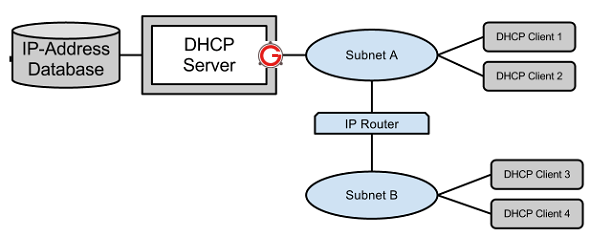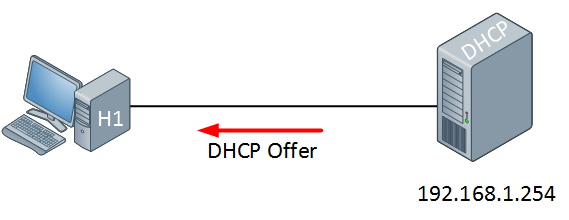Dhcp Uses Which Port S as the Destination
It is sent by the DHCP Server to DHCP Client. Offer source port 67 and destination port 68.

Dynamic Host Configuration Protocol Dhcp Ccna
Dynamic Host Configuration Protocol DHCP is a protocol for assigning dynamic IP addresses to devices on a network.

. UDP 67 bootps DHCP servers are listening on this port Layer 3 source port. Are the port numbers the same as in the example given in this lab assignment. Here both the client and the server use a well-known port.
The DHCPDISCOVER message is sent by a DHCPv4 client and targets a broadcast IP along with the destination port 67. Show activity on this post. Source port of 68 and destination port of 67 Offer packet.
Port Number Requirements for DHCP Firewall Filters. A DHCPDISCOVER message is sent with the IP address of the DHCP server as the destination address. DHCP Server uses the UDP port 67 and DHCP client uses UDP port 68.
When you configure a firewall filter to perform some action on DHCP packets at the Routing Engine such as protecting the Routing Engine by allowing only proper DHCP packets you must specify both port 67 bootps and port 68 bootpc for both the source and destination. The DHCP server operates on UDP port 67 and the DHCP client operates on UDP port 68. UDP port 67 for the DHCP server and UDP port 68 for the DHCP client.
UDP port 67 for the DHCP server and UDP port 68 for the DHCP client. UDP 68 bootpc The DHCP server responds with a DHCP Offer packet which includes the proposed IP address using 67 as the source port and 68 as the destination port. Access to the destination computers event log is required.
The DHCP server listens for messages heading for port 67 UDP while the DHCP client listens for messages on port 68 UDP. DiscoverOfferRequestACK DHCP exchange between the client and server. DHCP is based on the earlier BOOTP protocol which used ports 67 server and 68 client.
For each packet indicated the source and destination port numbers. The DHCP employs a connectionless service model using the User Datagram Protocol UDP. DHCP uses UDP Protocols and it uses port 67 for server side and port 68 for client side.
DHCP acknowledge message is the last message of the DORA process. The value of the transaction id in the first four DHCP messages is 0x2ab01e09. The DHCP Option section identifies the packet as an ACK.
DHCP server assigning Ips automatically to the clients computer. It is implemented with two UDP port numbers for its operations which are the same as for the BOOTP protocol. The DHCP is implemented with two UDP port numbers for its operations which are the same as for the bootstrap protocol BOOTP.
TFTP was created in 1981 and uses port 69 so it was a thing of using the nearest non-used ports 68 and 67. You can use this service to adjust the advanced network settings of DHCP clients. DHCP Server IP Address.
Layer 3 destination port. In most client-server-applications the port number of a server is a well-known number while the client uses a currently available port number. The value of the transaction id in the second set of DHCP messages is 0x9668802f.
Understanding DHCP Ports Dynamic Host Configuration Protocol DHCP is used to assign hosts IP addressing information dynamically which includes IP address subnet mask. This port is used only by the ISA management MMC during remote server and service status monitoring. Lets lake a look at a DORA sequence in Wireshark.
Source port of 67 and a destination port of 68. Here both the client and the server use a well-known port. DiscoverOfferRequestACK DHCP exchange between the client and server.
Many networks use DHCP to assign IP addresses to clients when they attempt to connect to the network for the first time. UDP port number 67 is the destination port of a server and UDP port number 68 is used by the client. What is DHCP in WIFI.
BOOTP uses TFTP as the file transfer protocol. These are privileged ports and they are reserved for DHCP only. The YIADDR field contains the clients address and the CHADDR and DHCP.
For each packet indicated the source and destination port numbers. UDP port number 67 is the destination port of a server and UDP port number 68 is used by the client. A DHCPDISCOVER message is sent with the broadcast IP address as the destination address.
This message is a reply to the DHCP Request message. The DHCP employs a connectionless service model using the User Datagram Protocol UDP. UDP port number 67 is the destination port of.
User Datagram Protocol UDP. While a host usually has a single IP address it can have thousands of ports. DHCP is based on the earlier BOOTP protocol which uses well known port numbers for both server and client instead of an ephemeral port.
The Source address is the DHCP server IP address and the Destination address is still 255255255255. DHCP is based on BOOTP which was created in 1985. DHCP assigns IP informatioin including IP address and default gateway DHCP Ports include DHCPDISCOVER message UDP port 67 DHCPOFFER message using UDP port 68.
A host uses DHCP to obtain an IP address among other things. IP address is assigned from a pool of addresses. In DHCP the client and the server exchange mainly 4 DHCP messages in order to make a connection also called DORA process but there are 8 DHCP messages in the process.
But a hosts IP address is not confirmed until the end of the four-message exchange. It is a Client server protocol which uses UDP services. DHCP stands for Dynamic Host Configuration Protocol.
It is implemented with two UDP port numbers for its operations which are the same as for the bootstrap protocol BOOTP. This message header has the following main fields. DHCP port number for server is 67 and for the client is 68.
Why BOOTP used those ports was probably because they were unused by any of the other protocols at the time SMTP uses 25 FTP uses 21 etc. The DHCP Server service uses the DHCP to automatically allocate IP addresses. Discover source port- 68 and destination port 67.
Are the port numbers the same as in the example given in this lab assignment. UDP port number 67 is the destination port of a server and UDP port number 68 is used by the client. DHCP UDP ports 67 and 68 In most client-server-applications the port number of a server is a well-known number while the client uses a currently available port number.
Client Identifier fields are the physical address of the network card in the requesting client.

What Is Dhcp And How Dhcp Works Dhcp Fundamentals Explained

A Wireless Host Needs To Request An Ip Address What Protocol Would Be Used To Process The Request In 2022 Ip Address Request Wireless

No comments for "Dhcp Uses Which Port S as the Destination"
Post a Comment